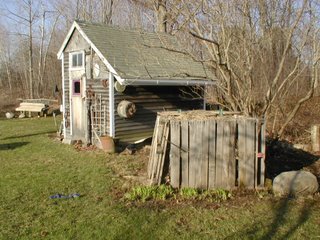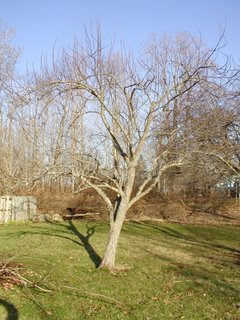 gree) lawn mowing is mind-numbingly boring in addition to wasteful of all kinds of resources, especially precious gardening time. Additional goals include improving bird habitat, and adding more vegetable garden, adding fruit trees and berries, and a cutting garden.
gree) lawn mowing is mind-numbingly boring in addition to wasteful of all kinds of resources, especially precious gardening time. Additional goals include improving bird habitat, and adding more vegetable garden, adding fruit trees and berries, and a cutting garden.To the left is a sunny perennial bed planted a year before my neighbor kindly decided to plant the row of arborvitae behind it. Perhaps he decided a barrier between his teenage children and
 I was a good idea. If so, he was right. If only the arborvitae offered protection from the dreadful music.... Further along is a hedge of hybrid lilacs planted in 2002 to screen out the dilapidated garage, with a row of tough-as nails orange daylillies in front. This area often has standing water for a week or two in early spring; the daylillies have proving up to the challenge of thriving in that difficult environment. The graite bench was put together with pieces of granite we
I was a good idea. If so, he was right. If only the arborvitae offered protection from the dreadful music.... Further along is a hedge of hybrid lilacs planted in 2002 to screen out the dilapidated garage, with a row of tough-as nails orange daylillies in front. This area often has standing water for a week or two in early spring; the daylillies have proving up to the challenge of thriving in that difficult environment. The graite bench was put together with pieces of granite we found, slowly subsiding into the brush piles in the backyard when we bought the house. Further along is a stretch of multiflora roses intermingled with japanese knotweed. What a mess! The roses are good bird habitat and provide badly needed privacy, so I've been reluctant to get a backhoe to haul out the whole mess (although I'd love to rent one of those little min-bulldozers, it looks very fun). The Japanese knotweed is such an aggressive spreader it is growing in the lawn, we keep it undercontrol there with mowing. Our strategy: last spring we planted elderberry shrubs, which are hardy spreading natives and good bird habitat. Now that we have some thing to provide some screening, we will slowly hack back, dig up, and if we
found, slowly subsiding into the brush piles in the backyard when we bought the house. Further along is a stretch of multiflora roses intermingled with japanese knotweed. What a mess! The roses are good bird habitat and provide badly needed privacy, so I've been reluctant to get a backhoe to haul out the whole mess (although I'd love to rent one of those little min-bulldozers, it looks very fun). The Japanese knotweed is such an aggressive spreader it is growing in the lawn, we keep it undercontrol there with mowing. Our strategy: last spring we planted elderberry shrubs, which are hardy spreading natives and good bird habitat. Now that we have some thing to provide some screening, we will slowly hack back, dig up, and if we must, use some Round-up to get rid of the knotweed and roses, and plant an evergreen hedge behind the elderberries, and create a mixed border amidst the elderberries.
must, use some Round-up to get rid of the knotweed and roses, and plant an evergreen hedge behind the elderberries, and create a mixed border amidst the elderberries.Perpendcular to the first of the elderberries will be a row of highbush blueberries, which will provide a hedge behind which is the vegetable garden and fruit trees. We have bales of hay covering the grass where the blueberries will go, set there to kill the sod underneath. We have lettuce and spring greens planted in one of the hoop houses, and will plant tomatoes in the other hoop house. The soil will warm early in the hoop house, and we can extend the season a bit in the fall. In the summer, the lettuce bed hoops will be used to hold up shade cloth, which both slows the lettuce from bolting, and is a strong deterrent to the ground hog warren which lives next door and comes to our yard to dine on premium organic greens.

Looking back toward our house, on the left, is our blackberry patch, in need of trellising. Two 3 year-old cherry tree lie behind the berries. Next to the garden shed is our materials inventory -- fieldstone salvaged from a retaining wall demolition, a good supply of old bricks, a pallet or 2 for a third compost bin. Also behind our berries is the kitchen garden sink, a salvaged old porcelain double-bowl sink which makes washing vegetables much easier!
 Then the garden shed with compost bins, deliberately placed under an ancient, woefully neglected, GORGEOUS dark purple lilac. We figured the compost might give it a needed boost. And finally, our overgrown Bartlett pear tree,
Then the garden shed with compost bins, deliberately placed under an ancient, woefully neglected, GORGEOUS dark purple lilac. We figured the compost might give it a needed boost. And finally, our overgrown Bartlett pear tree, showing last year's prodigious growth of water sprouts which it grew in response to a severe pruning by our friend Bill, now an
showing last year's prodigious growth of water sprouts which it grew in response to a severe pruning by our friend Bill, now an  archaeologist, formerly a highly skilled arborist.
archaeologist, formerly a highly skilled arborist.

No comments:
Post a Comment